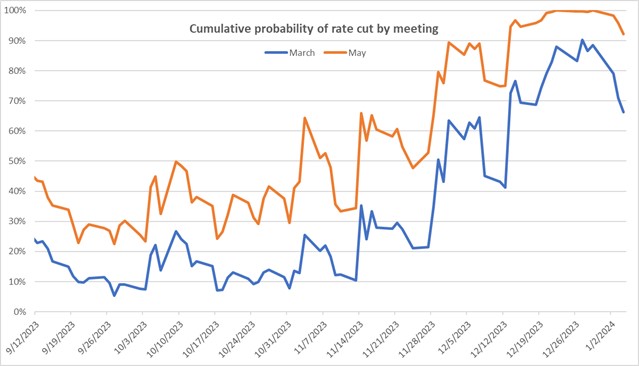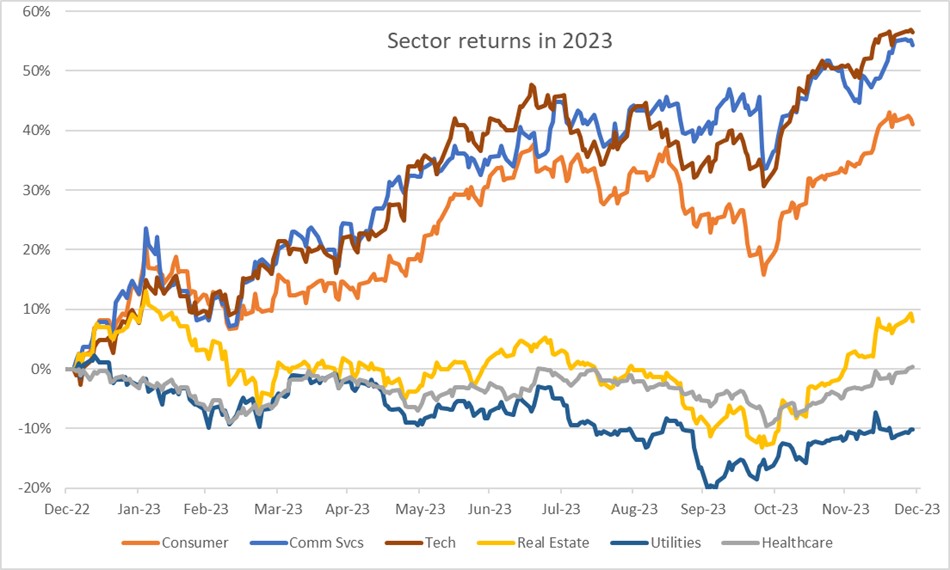What does the end of the rate-hiking cycle mean for stocks?
Executive summary:
- Interest rates are one of the most important factors affecting the economy and the outlook for stocks. Managers increasingly think interest rates in the U.S. have likely peaked and are repositioning equity portfolios for the new environment.
- Active equity manager outlooks are broadly positioned in two camps, expecting either a benign soft landing and reacceleration of growth without inflation, or an interest-rate-induced recession.
- The soft landing faction believe lower rates will drive increased growth and are repositioning their portfolios into long-duration growth assets and more highly levered companies.
- Managers in the recessionary camp believe the Federal Reserve will be forced to cut interest rates to cushion an economic slowdown brought about by the Fed’s prior rate hikes and are positioning portfolios more defensively.
Background
Interest rates are one of the most important factors affecting the economy and the outlook for equities. When interest rates rise, borrowing costs increase, which can reduce consumer spending and business investment, leading to lower economic growth. Conversely, when interest rates fall, borrowing costs decrease, which can stimulate consumer spending and business investment, leading to higher growth.
In an effort to bring inflation under control, in April 2022 the U.S. Federal Reserve embarked on a series of interest rate increases that proved to be one of the steepest in history, with rates moving from near zero in early 2022 to their current targeted range of 5.25%-5.50% in less than eighteen months. With the FOMC now having kept rates unchanged for three meetings since a 25-basis-point (bps) hike in July and inflation trending down toward the Fed’s 2% target, investors are increasingly of the mind that interest rates have peaked and are beginning to look forward to lower rates in the future. According to the CME’s FedWatch Tool, 30-day Fed fund futures are now pricing in more than a 60% chance of a 25-bps cut at the March 2024 FOMC meeting, and above a 90% chance of a 25-bps cut by the May 2024 meeting.
Source: CME FedWatch Tool, Russell Investments
No longer higher for longer
As noted in our recent Active Management Insights report, managers through the first three quarters of the year had positioned equity portfolios for a higher for longer interest rate environment, believing the Federal Reserve would maintain rates at an elevated level for a prolonged period of time until inflation sustainably fell below the Fed’s 2% target. With inflation continuing to trend down, active managers are now repositioning portfolios for the changing environment.
Lower rates can affect equities through both direct and indirect channels. Direct effects include those that impact financing or operational aspects of the underlying business. All else equal, lower interest rates mean lower interest expense (and therefore higher profits) and can also make capital spending projects more attractive, increasing potential growth rates.
Indirect effects largely manifest via valuation multiples, both in absolute terms and relative to alternatives. Present value calculations for future earnings and cash flows for stocks are tied to assumptions about interest rates. When investors anticipate lower rates in the future, it increases the present value of future earnings and (likely) the multiple investors are willing to pay on current earnings. Lower rates also reduce the relative attractiveness of cash and fixed income investments compared to stocks, which may also result in higher warranted equity valuations.
Two camps: Soft landing and recession
Active equity manager outlooks broadly belong in two camps, with managers expecting either a benign soft landing and reacceleration of growth without inflation, or an interest rate-induced recession.
Managers that believe the economy will achieve a soft landing over the coming year expect a slowdown in growth in the near-term (without the economy tipping into a recession) before a reacceleration of growth in the second half of 2024. Growth managers within this camp are adding to their high-conviction holdings in long-duration higher-growth assets, particularly within information technology and communication services. More value-oriented managers are shifting their portfolios toward more cyclical and more highly leveraged companies as their concerns over refinancing risks and the business cycle recede.
The managers taking the opposing view believe an inverted yield curve and the recent decline in longer-term rates are best explained by an impending economic contraction and recession brought about the Fed’s rate hikes. Growth and core managers taking this view are positioning their portfolios toward more defensive, resilient growth within healthcare and consumer staples, while more value-oriented managers are adding to holdings in rate-sensitive defensive sectors such as utilities and real estate that underperformed the broader market for much of 2023.
Chart: Select sector performance in 2023
Source: CME FedWatch Tool, Russell Investments

